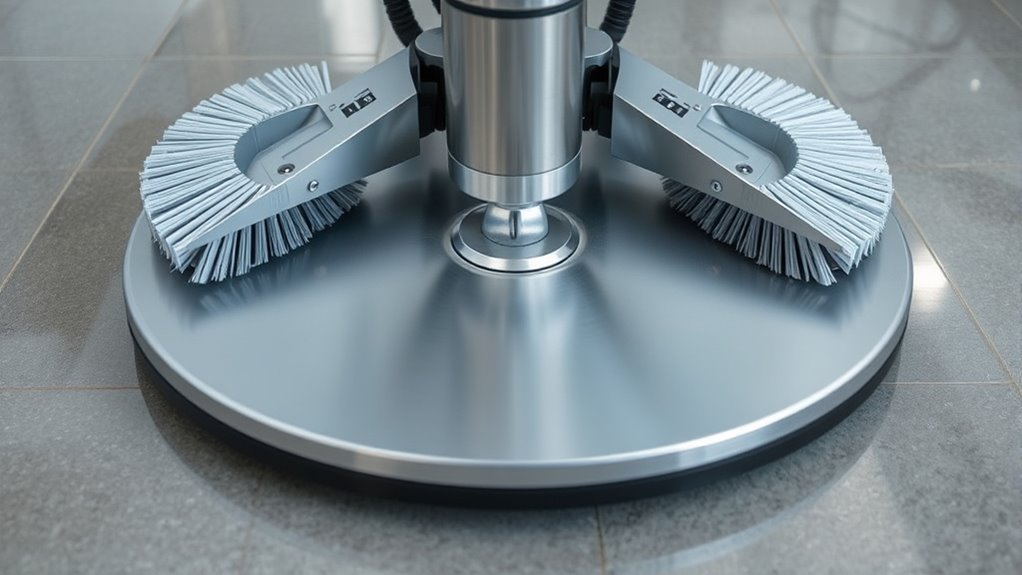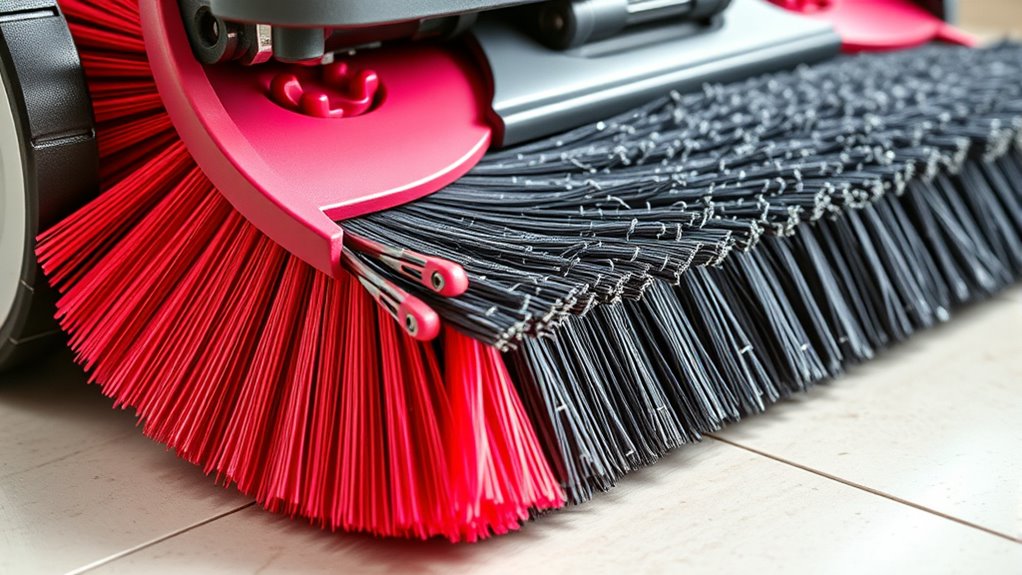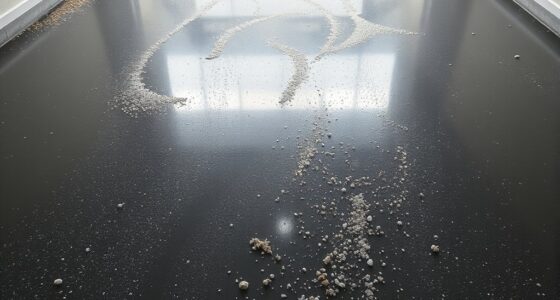Understanding side brooms and main broom angles helps you optimize your vacuum’s cleaning performance. Side brooms sweep debris from corners and edges, rotating at angles to direct dirt toward the main brush. Adjusting these angles ensures debris is effectively guided into the vacuum’s suction path without displacement. Proper material choice and angle setup can improve cleaning, especially on varied surfaces. Keep exploring to learn how fine-tuning these components can give you even better results.
Key Takeaways
- Side broom angles are adjustable to improve debris collection from corners and edges, directing debris into the main brush.
- Main broom angles influence agitation and dirt pickup efficiency, requiring proper alignment for optimal cleaning.
- Proper adjustment of both side and main broom angles ensures debris is effectively directed into the vacuum’s suction path.
- Selecting broom material (rubber, silicone, nylon) impacts durability, cleaning effectiveness, and suitability for different flooring types.
- Regular inspection and maintenance of broom angles and materials optimize cleaning performance and prevent debris missed or pushed around.

Understanding how side brooms and main broom angles work can considerably improve your vacuum’s cleaning efficiency. When you know how these components interact, you can optimize their performance to better pick up dirt, debris, and pet hair. One key aspect is understanding the broom material, as this influences durability and cleaning effectiveness. For example, rubber or silicone side brooms tend to glide smoothly over various surfaces, making them ideal for delicate floors. Meanwhile, bristled main brooms made of nylon or other stiff materials excel at agitating carpet fibers to dislodge dirt. Knowing the material helps you select or maintain the right broom for your flooring type and cleaning needs.
Next, consider how adjusting the angles of the side broom and main broom impacts cleaning. Angle adjustment techniques are essential because they determine how well the vacuum reaches into corners, along edges, and under furniture. Typically, side brooms are designed to rotate at a slight angle relative to the vacuum body, allowing them to sweep debris from edges directly into the path of the main brush. When you adjust the angle of the side broom, you can improve debris collection from tricky spots. For example, angling it slightly outward can help sweep dirt from corners more effectively, while a more neutral angle might be better for open surfaces.
The main broom’s angle also plays a key role, especially in relation to the suction path. Some vacuums allow you to tweak this angle slightly to optimize agitation and debris pickup. If your vacuum has adjustable angle settings, you can experiment with different positions to find the configuration that maximizes dirt removal without causing unnecessary wear or tangling. Proper angle adjustment techniques involve aligning the brooms so that they work synergistically—side brooms directing debris toward the main brush, which then pulls it into the vacuum’s suction chamber. Misalignment or incorrect angles can lead to missed spots or debris being pushed around instead of picked up.
In addition to adjusting angles, regularly inspecting the broom material and replacing worn brushes guarantees peak performance. Worn brushes lose their stiffness and cleaning power, which can be detrimental regardless of how well you adjust their angles. Additionally, staying informed about robotic vacuum features can help you utilize your device more effectively and maintain optimal performance. Combining the right broom material choice with proper angle adjustment techniques allows your vacuum to operate at full capacity. This means cleaner floors, less time spent on cleaning, and fewer frustrations with missed debris or frequent maintenance. In essence, understanding and maintaining the correct angles and materials of your side and main brooms is fundamental to achieving thorough, effective cleaning every time you use your vacuum.
Frequently Asked Questions
How Do Side Broom Angles Affect Cleaning Efficiency?
Side broom angles critically impact cleaning efficiency by directing debris toward the main broom. Proper side broom alignment ensures debris is swept into the path of the main brush, while angle optimization maximizes coverage and minimizes missed spots. When you adjust the side broom angles correctly, you improve overall cleaning performance, especially along edges and corners. Regularly fine-tuning these angles helps your machine operate more effectively and reduces the need for manual cleanup.
Can Side Broom Adjustments Improve Corner Cleaning?
You can definitely improve corner cleaning by adjusting the side broom. When you optimize the broom orientation, it enhances edge cleaning, making sure debris along walls and in corners gets swept efficiently. Small tweaks in angle can make a big difference, helping the broom reach tight spots more effectively. So, take a moment to fine-tune your side broom, and you’ll notice a cleaner, more thorough result in those tricky corners.
What Maintenance Is Required for Different Broom Angles?
To maintain different broom angles, you should regularly check and adjust the angle calibration to guarantee peak cleaning performance. Keep an eye on broom durability by inspecting for wear or damage, replacing parts as needed. Clean the broom components frequently to prevent debris buildup. Proper maintenance preserves the broom’s effectiveness, extends its lifespan, and ensures consistent cleaning, especially in hard-to-reach corners. Regular checks keep everything operating smoothly.
Are Certain Angles Better for Specific Floor Types?
Yes, certain angles are better for specific floor types. For smooth, hard floors like tile or hardwood, a lower broom angle improves debris pickup without scratching. For carpets, a steeper angle helps lift dirt more effectively. Always check broom angle compatibility with your floor type to maximize cleaning efficiency and prevent damage. Adjusting the angle accordingly ensures *best* performance and prolongs your equipment’s lifespan.
How Do Broom Angles Influence Debris Pick-Up in Tight Spaces?
You’ll notice that adjusting broom angles greatly impacts debris pickup in tight spaces. A steeper angle concentrates power, reducing dust accumulation and preventing debris dispersion, while a shallower angle might spread debris around instead of capturing it. By fine-tuning these angles, you improve efficiency, ensuring dust and debris are effectively collected without scattering, making your cleaning more thorough and less frustrating—especially in those hard-to-reach corners.
Conclusion
Think of side brooms and main broom angles as the compass and map guiding your cleaning journey. When you grasp how their angles direct debris, you steer your effort effectively, like a skilled navigator charting a course through uncharted waters. Mastering these angles guarantees your cleaning voyage is smooth and thorough. Remember, understanding these tools converts your vacuum from a simple device into a precision instrument, turning chaos into order with every pass.









